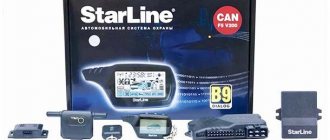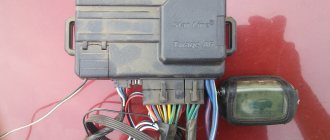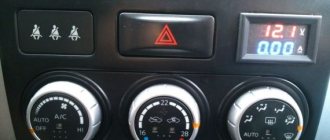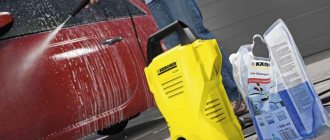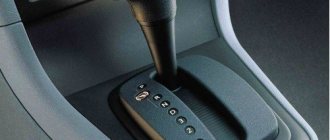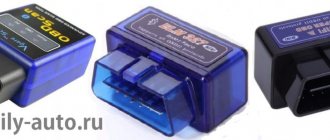11 February 2020 Lada.Online 27 068 6
The telescopic screw rack jack (article 8450031895) can be a standard jack on Lada Vesta, Granta, Kalina, Priora and Datsun cars. It is made of plastic (both of its screws are made of plastic), so as not to break it or damage the car, it is recommended that you read the instruction manual for this jack before use.
Preparing for work
Position of the tool in the organizer and sequence of work with the jack.
6.1
Before starting work, clean the supporting surface of the car body from dirt, prepare a platform on the ground for installing the jack.
Where to place the jack using the Lada Vesta as an example (there are protrusions in the indicated places):
6.2
Check that the jack has no mechanical damage, that the screw pairs are lubricated and not dirty. Brake the car following paragraph 2.2.
Analogue - which was recognized by Vestavods
If Vesta car owners decide to replace their standard jack with a better analogue, the performance characteristics of the tool and its size become important to them. If a new jack takes the place of the factory one, it must fit into a small foam niche, and not every tool can do this.
One of the favorite analogues among Lada Vesta owners was the AUTOPROFI DVB-20-Lo screw jack. This baby can handle cars weighing up to two tons, but at the same time neatly fits into the niche of the standard Lada jack. The price also cannot but please car enthusiasts. It will cost you approximately: 1500-2000 rubles.
You can purchase other, more expensive, massive and reliable lifting mechanisms, but you will have to allocate additional space for them. If you plan to use it in emergency situations, then this is not economically profitable. If the purpose is to change tires annually, in winter and summer, it’s worth spending a little more money, but choosing a good one.
Weaknesses x ray
Today, when enough time has passed since the “birth” of the car, we can draw conclusions regarding expectations and reality. The first wave of test drives was picked up by automotive journalists, who subsequently began to echo statements from owners who became happy owners of production cars. So, the main disadvantages that were identified experimentally include:
- Absence of any plastic trim on the fenders and sills. This, at first glance, insignificant detail can immediately disqualify the car from claiming the title of crossover, since all potentially dangerous off-road areas are simply painted. This suggests that meeting this car with poor road conditions will threaten the rapid loss of its original appearance, from which nothing protects the car.
- The car is not maneuverable. Its lateral stability capabilities seem to hint that the car is simply not designed for this. When trying to turn into a corner at high speed, be prepared to feel the resistance of the car, in the form of a large roll.
- There is no reach adjustment for the steering wheel. On the one hand, we are talking about a budget car, for which this omission is excusable, but this can be safely written down as a disadvantage, since this fact affects the convenience of driving.
- Drum brakes are installed at the rear. Their installation is easily explained by the budget concept of the car, but car enthusiasts claim that they would be willing to pay extra in order to correct this misunderstanding. In fact, the drums are able to provide the necessary braking, which has been proven by various tests, but the opinion of car enthusiasts is adamant.
- Controversial ABS. According to the manufacturers, its configuration exactly corresponds to the off-road conditions of Russian open spaces, but this concept does not always work. It is noted that its operating mode is more suitable for driving on hills (in this case, it is surprising that they did not add a diesel option).
- There is no gas strut in the hood. A trifle, but unpleasant, especially considering the fact that 14 Lada models have it.
- The body is a tinsmith's nightmare. Yes, beautiful, noble. In some places, it even smells like Cayenne, but that’s all before the first accident. When receiving dents that in any way touch the branded X, the owner can expect only one outcome - purchasing a new body part. There can be no talk of straightening, since even eminent craftsmen assure that complete restoration of the geometry of the tin is beyond their control.
Standard jack
A factory tool causes opposite responses from car owners. Some say that it is light and compact, takes up little space in the trunk and is easy to use. Others consider the factory lift to be a mockery of manufacturers. It looks too flimsy, and not every driver decides to use such a “toy” for its intended purpose.
In fact, the car comes with a small plastic bottle-type jack. It is designed to lift a vehicle weighing no more than one ton on a hard, level surface. Its service life is not very long. You will most likely be able to change the wheel a couple of times, but on the third you will definitely notice that the lift is undergoing changes and bends. Some car enthusiasts encounter this problem even earlier.
The lifting height of the standard jack is small for comfortable work. They are barely enough to change a tire. Sometimes you even have to use additional lifting aids. On uneven and soft surfaces (such as sand), operation becomes dangerous.
Types of jacks
- The machine tools market offers a wide selection of jacks. The most popular of them:
- mechanical - have a limited load capacity, but can be used in any weather: even in severe frost.
- rolling - usually used in car repair shops due to its large size. Easily moves from one wheel to another as it is equipped with wheels.
- screw - belong to the group of mechanical ones, and therefore are also limited in load capacity. They have a small point of support, and therefore are considered not the safest.
- Inflatable - has a large load capacity and reliability, is convenient to use and does not take up too much space. The truth has a high price compared to others.
Any car should have a compact lifting mechanism, since the need to replace a wheel always arises unexpectedly and in the most inconvenient places. If you often travel outside the city, it is better to replace the standard tool with a more reliable one, with the ability to install it on uneven roads.
How to use it correctly
Looking at the small size and flimsy appearance of the standard product, drivers often wonder where to put the jack so that it does not break and can lift the car? Where should the car itself be parked? Indeed, for a plastic tool to help change a wheel properly, not every surface is suitable for it. Only smooth, hard as asphalt. Changing a tire using a standard tool in the sand or in dirty slush means not being able to lift the car off the ground to a sufficient height.
Places where the jack rests on the car - for this purpose, there is a place on the thresholds marked with an embossed triangle where the tool should be placed so as not to damage the body. And in order for the standard lift to stand up straight, it has a special hook that can be used to hook it to the car. If you do everything correctly, the car itself will not be damaged when replacing a wheel. At the same time, if the lift is installed incorrectly, the car will rock or worse, the tool will break and it will fall to the bottom. Try to park the machine on a prepared area or be prepared to use auxiliary materials (for example, boards).
What type of jack is better to choose?
There are several types of jacks: mechanical, hydraulic, electromechanical/electrohydraulic and pneumatic.
– the simplest and inexpensive models, with a load capacity of up to 2 tons. Compact, reliable, but require great physical effort. Diamond-shaped jacks and those that resemble a bottle are perfect for the Lada Vesta cross and sedan. They provide sufficient lift height for their ground clearance.
– lift the weight using hydraulic fluid. The pump pumps oil into the hydraulic cylinder, providing sufficient pressure for the rod to exit. The advantage of hydraulics is that it requires minimal effort from the driver. But they are bulky and require a flat surface.
This includes mechanical and hydraulic jacks that are driven by an electric motor. They are suitable for any car (you need to focus on the pick-up height and load capacity), working with them does not require any effort. Some models have a built-in battery, some are connected to the on-board network. But this type of jack is expensive, heavy and bulky.
Jacks lift a car by inflating the air cushion. They are universal, suitable for rescuing cars stuck in mud, but are much more expensive than other models and are not yet widespread.
How not to spoil the body of a Lada Vesta: 1 comment
Uniform coverage is obtained using the first two methods. Lada Vesta is galvanized using the third technology, but whether or not the VAZ has a galvanized bath is another question.
Every day, before leaving on the roads of the test site, we make sure to check the tire pressure and levels of working fluids: brake, coolant, and engine oil on Lada Vesta and XRAY vehicles undergoing accelerated life tests.
And they immediately began to notice that Vesta’s level of brake fluid decreases with every thousand kilometers traveled.
Without waiting for 9 thousand kilometers, the fluid in Vesta’s reservoir approached the minimum mark - the TRW pads installed on the conveyor were worn down to almost “zero”! Only the Chinese Geely Emgrand EC7 has previously demonstrated a similar speed of eating pads (only the rear ones).
As a replacement, we prepared the same TRW purchased from an official dealer, and at the same time we decided to test the standard jacks of both cars.
Replacing the air filter x ray
This procedure can also confuse inexperienced car owners, but in the current times AvtoVAZ has done everything possible to simplify this procedure.
Since the car likes to breathe dust-free air, it is recommended to change the engine filter twice a year - in spring and autumn. The procedure itself takes no more than 15 minutes and does not require any tools. The filter is accessible through the open hood. There is no need to unscrew or unscrew anything. It is located immediately behind the battery, and can be removed by applying a little force after snapping the left and right latch. Replacement is also easy - the old filter is taken out without much effort, a new one is installed in its place, and the housing with the filter is installed back.
How to use it correctly
Looking at the small size and flimsy appearance of the standard product, drivers often wonder where to put the jack so that it does not break and can lift the car? Where should the car itself be parked? Indeed, for a plastic tool to help change a wheel properly, not every surface is suitable for it.
Places where the jack rests on the car - for this purpose, there is a place on the thresholds marked with an embossed triangle where the tool should be placed so as not to damage the body. And in order for the standard lift to stand up straight, it has a special hook that can be used to hook it to the car. If you do everything correctly, the car itself will not be damaged when replacing a wheel.
Where is the jack in Lada Vesta?
Since we are talking about the fact that there is a special place in the trunk of the Lada for the jack, it is worth saying where it is. You can find the standard tool where the spare tire is. There is also a wheel wrench and a towing eye. The spare wheel has a foam niche into which tools are inserted. That’s why they don’t fly around the trunk and don’t take up any special space.
If you are not one of those owners who always have a spare tire, you can use the tool niche separately. True, it will hang around the trunk, so you will have to somewhat strengthen the structure.
